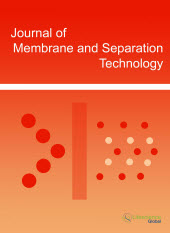jmst
Abstract : Evaluating the Performance of Fertilizer Draw Solutions by Using the Modified Cellulosic Composite Forward Osmosis Membranes
|
|
Abstract: This paper deals with various fertilizer influences to draw solutions to the neat CTA/CA, MA/CTA/CA, and the Al2O3/MA/CTA/CA nanocomposite (NC) modified membrane. Also, the applicability of the neat CTA/CA, MA/CTA/CA, and The Al2O3/MA/CTA/CA nanocomposite (NC) modified membrane display high water flux when it used to desalinate brine water sample collected from the brine mid-stream from Mersa Matruh area, North-Western Coast of Egypt. The salinity of the collected sample is 12760 mg/L and PH (8.5) and used as FS, and 1M from different fertilizer draw solutes (DFDS) include KCl, NH4Cl, (NH4)2SO4, and K2HPO4 used as DS. The results reveal that the flux was KCl and NH4Cl (17.8 L/m2.h) and followed by (NH4)2SO4 (17.1 L/m2.h) and K2HPO4 (16.6 L/m2.h) using the natural saline water as FS using Al2O3/MA/CTA/CA NC modified membrane. The reusability test of the synthesised Al2O3/MA/CTA/CA NC modified membrane showed good sustainability during the 1260 min continuous test. The FO application displayed a great potential to be interested in brine wastewater desalination and enhanced water source sustainability to use in agriculture fertigation. Keywords: Forward Osmosis Desalination, CTA/CA polymer blend, Fertilizer draws solution, brine wastewater desalination. |
Abstract : A Comparison between Several Commercial Polymer Hollow Fiber Membranes for Gas Separation
|
|
Abstract: Polyethersulfone (PES), polyetherimide (Ultem® 1000), and polyimide (Matrimid® 5218) are common commercial polymers used to produce hollow fiber membranes for different gas separation applications. In this work, asymmetric hollow fiber membranes were prepared using these polymers by a phase inversion technique. The effects of spinning parameters (composition of the dope and bore solution, bore flow rate, air gap distance, temperature of the spinneret and coagulation bath, as well as take-up speed) on the membrane structure and gas permeation properties were investigated. The membrane separation performances were characterized by measuring their gas permeation properties (permeance and selectivity) for different gases (H2, CO2, O2, N2, and CH4) and by their cross-sectional morphology using scanning electron microscopy (SEM). The relationships between the gas separation performance of the hollow fibers and the intrinsic gas properties of the dense flat membranes made of the same materials were also studied. A comparison between the average apparent skin layer thickness calculated from O2 permeability/permeance, and the results based on SEM images was made and good agreement was obtained between both results. Keywords: Polymer, membrane, gas separation, permeability, permeance, selectivity. |
Abstract : Polymeric Pseudo-Liquid Membranes from Polymethacrylate Derivative Bearing Oligodimethylsiloxane Unit
|
|
Abstract: Novel liquid membrane system, which is named polymeric pseudo-liquid membrane was constructed from polymethacrylate derivative bearing oligodimethylsiloxane (PDMSMA), showing rubbery state under operating conditions, as a membrane matrix. In the present study, dibenzo-18-crown-6 (DB18C6), dibenzo-21-crown-7 (DB21C7) or O-allyl-N-(9-anthracenylmethyl)cinchonidinium bromide (AMCC) was adopted as a carrier for KCl transport, CsCl transport or optical resolution of racemic mixture of phenylglycine (Phegly), respectively. The results of KCl and CsCl transports revealed that the membrane transport was attained by carrier-diffusion mechanism like conventional liquid membranes. The present study led the conclusion that PDMSMA can be applicable not only to membrane transport of alkali metal ions, such as K+ and Cs+, but also to chiral separation. Keywords: Chiral separation, Crown ether, Liquid membrane, Optical resolution, Polymeric pseudo-liquid membrane. |
Abstract : Catalytic Recovery of Elemental Sulfur Using a Novel Catalytic Membrane Reactor at Room Temperature with a Layer of Dispersed Mo-Co/γ-Al2O3 Catalyst: Reaction Kinetics and Mass Transfer Study
|
|
Abstract: The mass transfer rate of catalytic recovery of sulfur is investigated, enters through the catalyst-membrane interface (layer), accompanied by pseudo-first order irreversible reaction. Reaction kinetics is measured considering the system as a homogeneous system due to the consideration of mixed flow patterns of the reacting fluids, though the catalysis is a heterogeneous one. The multi-reactant mass transfer behaviour of the catalytic membrane reactor (CMR) is also studied on the basis of Maxwell-Stefan theory to understand the diffusion of reactants inside the membrane reactor. The mass transport behaviour and the performance of the fabricated CMR are strongly influenced by the reaction conditions, such as, reaction equilibrium constant (Keq) and membrane properties, namely, membrane area and reactor volume. An intermediate value with asymptotic nature of Keq as a function of time indicates appreciable performance of the catalytic membrane. On the other hand, the minimum value of kij indicates a negligible effect on mass transfer over the reactor performance. Keywords: Polymer, membrane, gas separation, permeability, permeance, selectivity. |






















